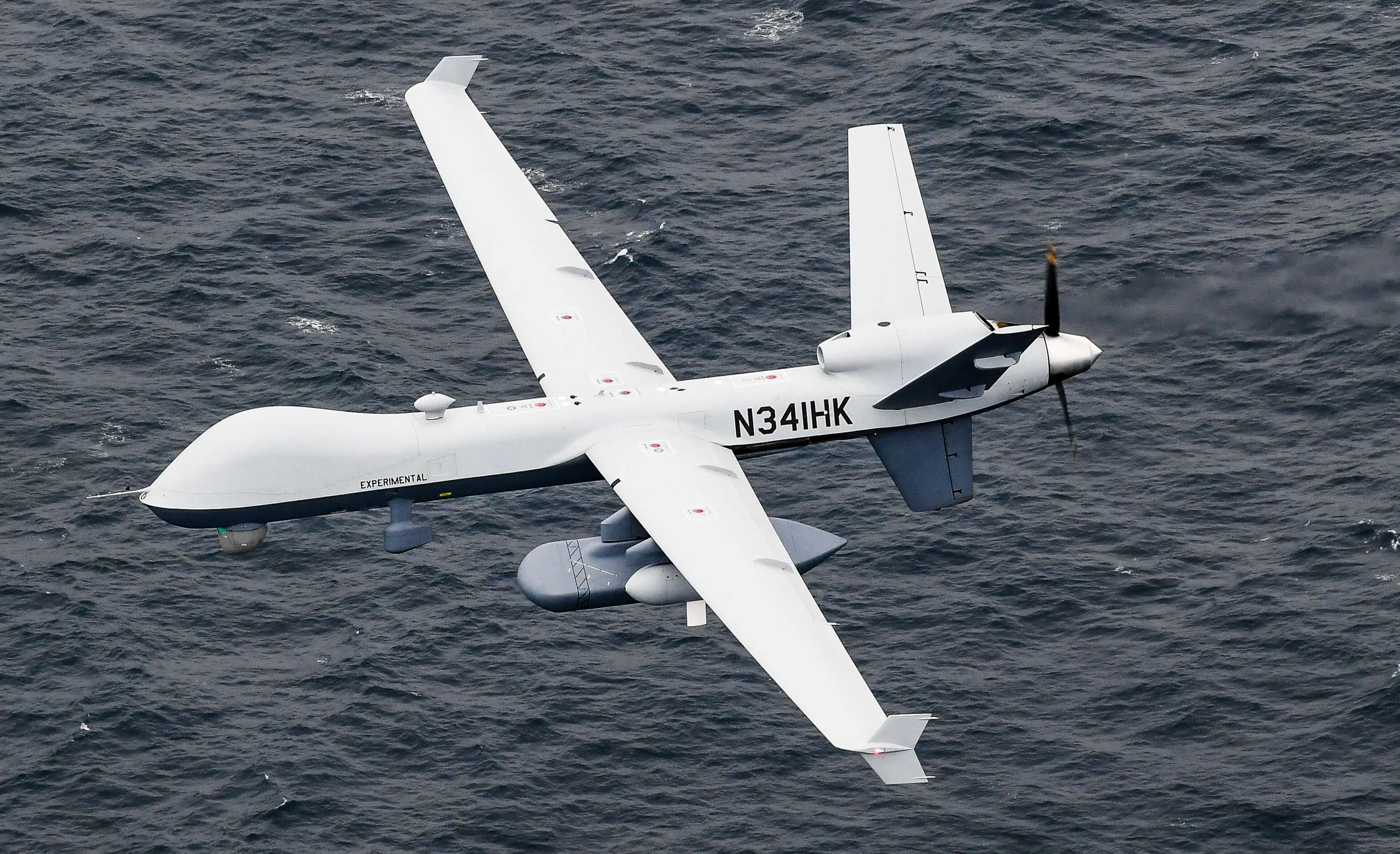
Japan will carry out trials of the MQ-9B Sea Guardian unmanned air vehicle (UAV) over the East China Sea from July to September this year, revealed Japan Defense Minister Minoru Kihara during a Friday press conference.
When asked about it during his regular post-cabinet press conference, the Japanese defense chief said the Japan Maritime Self-Defense Force (JMSDF) has been conducting trials of the Sea Guardian at JMSDF Hachinohe airbase (located on the main island of Honshu) since May of last year. He also said that from July to September, the UAV will operate from JMSDF Kanoya Air Base (located on the main island of Kyushu) and a simulated alert surveillance over the East China Sea will be carried out three times as part of the trials. Kihara stated the purpose of the trials was to determine if unmanned systems could replace some of the missions carried out by manned aircraft such as surveillance and warning. Currently, a single Sea Guardian is being trialed by the JMSDF.
JMSDF Kanoya Air Base previously hosted UAVs with the U.S. Air Force operating eight MQ-9 Reapers from November 2022 to November 2023. The UAVs subsequently were relocated to Kadena Air Base on Okinawa. Kanoya is also home base to JMSDF Fleet Air Wing 1, whose P-1s and P-3C Orions maritime patrol aircraft routinely track and shadow Russian Navy and People’s Liberation Army Navy (PLAN) ships passing through or conducting operations around Japan’s southwest islands.
The southwest islands include the disputed Senkaku Islands, which are held by Japan and claimed by China. As such, Japan has been stepping up its military presence and activities in the southwest islands and with procuring standoff weapons for island defense. The requirement for an increased military presence around the southwest islands also resulted in the annual U.S. Marine Corps and Japan Ground Self Defense Force (JGSDF) exercise Iron Fist being relocated last year from Camp Pendleton, California, to around the southwest islands.
This year’s iteration of Iron Fist will be carried out from Feb. 24 – Mar. 17, according to a Feb. 2 JGSDF release. The release also stated that other countries will be invited as observers to the drills though it did not state which countries would participate as observers.
The release stated that the training locations would be Camp Ainoura in Sasebo, Camp Hansen in Okinawa and Okinoerabu Island, part of the Amami Islands archipelago which lies southwest of the main island of Kyushu and Camp Takayubara, Kyushu. Camp Ainoura is home to the JGSDF Amphibious Rapid Deployment Brigade (ARDB), while Camp Hansen is a Marine Corps base that hosts the training facilities that will be used for the exercise. Aviation exercises related to the exercise will be staged from JGSDF Camp Takayubara.
The 31st Marine Expeditionary Unit (MEU) will spearhead the U.S element of the exercise along with ships of the America Amphibious Ready Group (ARG) on which it is embarked. The ARAG will consist of amphibious assault ship USS America (LHA-6), amphibious transport dock USS Green Bay (LPD-20) and amphibious transport dock USS Rushmore (LSD-47). The JGSDF Western Army will be in overall command of Japanese forces with JGSDF units being the ARDB, 1st Helicopter Brigade, along with various supporting units assigned to the Western Army. JMSDF landing ship tank JS Kunisaki (LST-4003) will provide amphibious lift. With Marine Corps MV-22Bs Ospreys still grounded under an operator wide grounding order by the Pentagon, Marine Corps CH-53E Super Stallions will likely carry out the air assault and transportations missions for the exercise. Even if the grounding was to be lifted before the exercise, MV-22Bs crews will have to undergo recertification for operational flights.
The America ARG and the 31st MEU are currently operating in the Philippine Sea around Japan, with its sub units conducting various training exercises and activities. Recently, III MEF Marines of the 5th Air Naval Gunfire Liaison Company (ANGLICO) and 3rd Intelligence Battalion, III MEF Information Group (MIG) carried out Exercise Rapid Tanto on the island of Ie Shima, which lies of the coast of Okinawa, according to a Thursday Marine Corps release. The exercise implemented the expeditionary advanced base (EAB) concepts outlined in the Marine Corps’ modernization, according to the release.
“The ANGLICO detachment’s primary mission for Rapid Tanto is to insert onto Ie Shima with Maritime Surveillance Teams to assist in setting up radar systems and establishing an EAB to provide maritime domain awareness, utilizing commercial and tactical assets to disseminate track data,” says Capt. Yiannis Rizos, the team lead for Rapid Tanto, in the release.
“Rapid Tanto provided advanced training to 5th ANGLICO and 3rd Intel Bn in developing accurate maritime sensing capability. During this exercise the units demonstrated their ability to act as one integrated force, capable of supporting joint maritime campaigns, and operating in an increasingly contested Indo-Pacific,” concluded the release.





